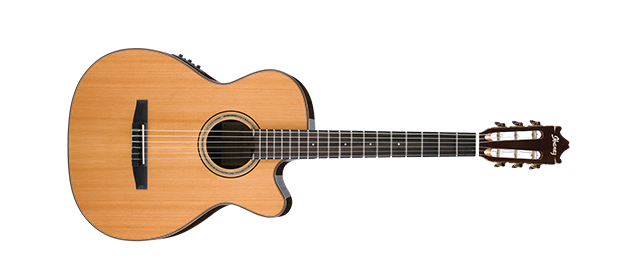Guitar

Overview
The guitar is a musical instrument classified as a string instrument with anywhere from 4 to 18 strings, usually having 6. The sound is projected either acoustically or through electrical amplification (for an acoustic guitar or an electric guitar, respectively). It is typically played by strumming or plucking the strings with the right hand while fretting (or pressing against the frets) the strings with the fingers of the left hand. The guitar is a type of chordophone, traditionally constructed from wood and strung with either gut, nylon or steel strings and distinguished from other chordophones by its construction and tuning.
Categories
Classical guitars: Classical guitars, also known as "Spanish" guitars, are typically strung with nylon strings, plucked with the fingers, played in a seated position and are used to play a diversity of musical styles including classical music. The classical guitar's wide, flat neck allows the musician to play scales, arpeggios, and certain chord forms more easily and with less adjacent string interference than on other styles of guitar. Flamenco guitars are very similar in construction, but they are associated with a more percussive tone.
Flat-top guitars: Flat-top or steel-string guitars are similar to the classical guitar, however, within the varied sizes of the steel-stringed guitar the body size is usually significantly larger than a classical guitar, and has a narrower, reinforced neck and stronger structural design. The robust X-bracing typical of the steel-string was developed in the 1840s by German-American luthiers, of whom Christian Friedrich "C. F." Martin is the best known. Originally used on gut-strung instruments, the strength of the system allowed the guitar to withstand the additional tension of steel strings when this fortunate combination arose in the early 20th century.
Archtop guitars: Archtop guitars are steel-string instruments in which the top (and often the back) of the instrument are carved, from a solid billet, into a curved, rather than a flat, shape. This violin-like construction is usually credited to the American Orville Gibson (1856–1918). Lloyd Loar of the Gibson Mandolin-Guitar Mfg. Co introduced the violin-inspired "F"-shaped hole design now usually associated with archtop guitars, after designing a style of mandolin of the same type. The typical archtop guitar has a large, deep, hollow body whose form is much like that of a mandolin or a violin-family instrument.
Electric guitars: Electric guitars can have solid, semi-hollow, or hollow bodies; solid bodies produce little sound without amplification. Electromagnetic pickups convert the vibration of the steel strings into signals, which are fed to an amplifier through a patch cable or radio transmitter. The sound is frequently modified by other electronic devices (effects units) or the natural distortion of valves (vacuum tubes) or the pre-amp in the amplifier. There are two main types of magnetic pickups, single- and double-coil (or humbucker), each of which can be passive or active. The electric guitar is used extensively in jazz, blues, R & B, and rock and roll.
Bass guitar: The bass guitar (also called electric bass, or simply bass) is a stringed instrument played primarily with the fingers or thumb, by plucking, slapping, popping, strumming, tapping, thumping, or picking with a plectrum, often known as a pick. The bass guitar is similar in appearance and construction to an electric guitar, but with a longer neck and scale length, and four to six strings or courses. The four-string bass, by far the most common, is usually tuned the same as the double bass, which corresponds to pitches one octave lower than the four lowest pitched strings of a guitar (E, A, D, and G). The bass guitar is a transposing instrument, as it is notated in bass clef an octave higher than it sounds (as is the double bass) to avoid excessive ledger lines. Like the electric guitar, the bass guitar has pickups and it is plugged into an amplifier and speaker for live performances.

